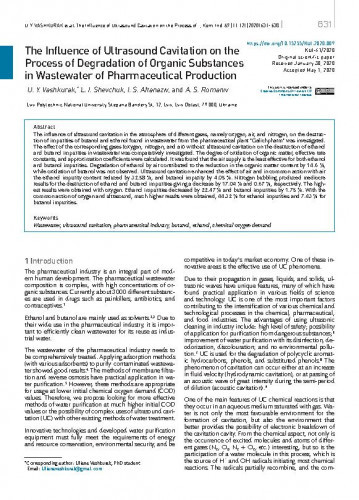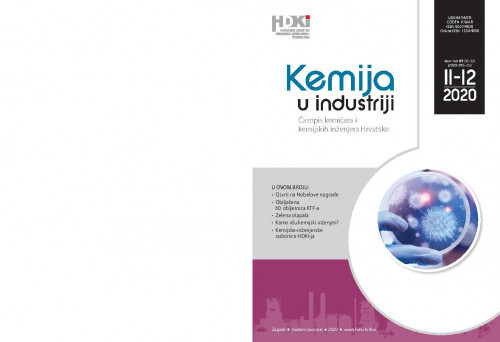The influence of ultrasound cavitation in the atmosphere of different gases, namely oxygen, air, and nitrogen, on the destruction of impurities of butanol and ethanol found in wastewater from the pharmaceutical plant “Galichpharm” was investigated. The effect of the corresponding gases (oxygen, nitrogen, and air) without ultrasound cavitation on the destruction of ethanol and butanol impurities in wastewater was comparatively investigated. The degree of oxidation of organic matter, effective rate constants, and approximation coefficients were calculated. It was found that the air supply is the least effective for both ethanol and butanol impurities. Degradation of ethanol by air contributed to the reduction in the organic matter content by 14.6 %, while oxidation of butanol was not observed. Ultrasound cavitation enhanced the effect of air and in common action with air the ethanol impurity content reduced by 32.58 %, and butanol impurity by 4.05 %. Nitrogen bubbling produced mediocre results for the destruction of ethanol and butanol impurities giving a decrease by 17.04 % and 0.67 %, respectively. The highest results were obtained with oxygen. Ethanol impurities decreased by 22.47 % and butanol impurities by 1.75 %. With the common action of oxygen and ultrasound, much higher results were obtained, 44.32 % for ethanol impurities and 7.43 % for butanol impurities.; Ispitan je utjecaj ultrazvučne kavitacije u atmosferi različitih plinova (kisika, zraka i dušika) na razgradnju onečišćujućih tvari butanola i etanola farmaceutskih otpadnih voda tvornice “Galichpharm”. Usporedno je ispitan i utjecaj kisika, dušika i zraka bez ultrazvučne kavitacije na uklanjanje onečišćujućih tvari etanola i butanola u otpadnim vodama. Izračunati su stupanj oksidacije organskih tvari, efektivne konstante brzine i koeficijenti aproksimacije. Otkriveno je da je dovod zraka najmanje učinkovit za onečišćujuće tvari etanola i butanola. Oksidacija etanola zrakom doprinosi smanjenju sadržaja organskih tvari za 14,6 %, dok oksidacija butanola nije promatrana. Ultrazvučna kavitacija pojačala je učinak zraka i u zajedničkom djelovanju sa zrakom sadržaj nečistoća etanola smanjen je za 32,58 %, a butanola za 4,05 %. Uvođenje mjehurića dušika kod razgradnje nečistoća etanola i butanola dalo je osrednje rezultate te je utjecalo na smanjenje od 17,04 % i 0,67 %. Najviši rezultati postignuti su kisikom. Nečistoće etanola smanjile su se za 22,47 %, a nečistoće butanola za 1,75 %. Uobičajenim djelovanjem kisika i ultrazvuka dobiveni su znatno viši rezultati – za nečistoće etanola 44,32 %, a za nečistoće butanola 7,43 %.
Sažetak

 Kemija u industriji : 69,11/12 (2020) / glavni i odgovorni urednik Nenad Bolf.
Kemija u industriji : 69,11/12 (2020) / glavni i odgovorni urednik Nenad Bolf.